Related Research Articles

Albert Einstein was a German-born theoretical physicist who is widely held as one of the most influential scientists. Best known for developing the theory of relativity, Einstein also made important contributions to quantum mechanics. His mass–energy equivalence formula E = mc2, which arises from special relativity, has been called "the world's most famous equation". He received the 1921 Nobel Prize in Physics "for his services to theoretical physics, and especially for his discovery of the law of the photoelectric effect", a pivotal step in the development of quantum theory.

Max Karl Ernst Ludwig Planck was a German theoretical physicist whose discovery of energy quanta won him the Nobel Prize in Physics in 1918.
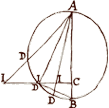
The Max Planck Institute for the History of Science is a scientific research institute founded in March 1994. It is dedicated to addressing fundamental questions of the history of knowledge from the Neolithic era to the present day, and its researchers pursue a historical epistemology in their study of how new categories of thought, proof, and experience have emerged in interactions between the sciences and their ambient cultures.

Max Theodor Felix von Laue was a German physicist who received the Nobel Prize in Physics in 1914 for his discovery of the diffraction of X-rays by crystals.
In theoretical physics, general covariance, also known as diffeomorphism covariance or general invariance, consists of the invariance of the form of physical laws under arbitrary differentiable coordinate transformations. The essential idea is that coordinates do not exist a priori in nature, but are only artifices used in describing nature, and hence should play no role in the formulation of fundamental physical laws. While this concept is exhibited by general relativity, which describes the dynamics of spacetime, one should not expect it to hold in less fundamental theories. For matter fields taken to exist independently of the background, it is almost never the case that their equations of motion will take the same form in curved space that they do in flat space.

Marcel Grossmann was a Swiss mathematician who was a friend and classmate of Albert Einstein. Grossmann came from an old Swiss family in Zürich. His father managed a textile factory. He became a Professor of Mathematics at the Federal Polytechnic School in Zürich, today the ETH Zurich, specializing in descriptive geometry.
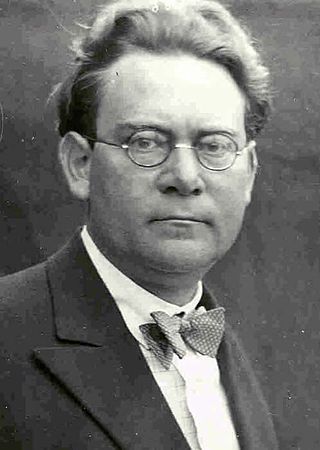
Hans Reichenbach was a leading philosopher of science, educator, and proponent of logical empiricism. He was influential in the areas of science, education, and of logical empiricism. He founded the Gesellschaft für empirische Philosophie in Berlin in 1928, also known as the "Berlin Circle". Carl Gustav Hempel, Richard von Mises, David Hilbert and Kurt Grelling all became members of the Berlin Circle.
The history of special relativity consists of many theoretical results and empirical findings obtained by Albert A. Michelson, Hendrik Lorentz, Henri Poincaré and others. It culminated in the theory of special relativity proposed by Albert Einstein and subsequent work of Max Planck, Hermann Minkowski and others.
Ernst J. L. Gehrcke was a German experimental physicist. He was director of the optical department at the Reich Physical and Technical Institute. Concurrently, he was a professor at the University of Berlin. He developed the Lummer–Gehrcke method in interferometry and the multiplex interferometric spectroscope for precision resolution of spectral-line structures. As an anti-relativist, he was a speaker at an event organized in 1920 by the Working Society of German Scientists. He sat on the board of trustees of the Potsdam Astrophysical Observatory. After World War II, he worked at Carl Zeiss Jena, and he helped to develop and become the director of the Institute for Physiological Optics at the University of Jena. In 1949, he began work at the German Office for Materials and Product Testing. In 1953, he became the director of the optical department of the German Office for Weights and Measures.
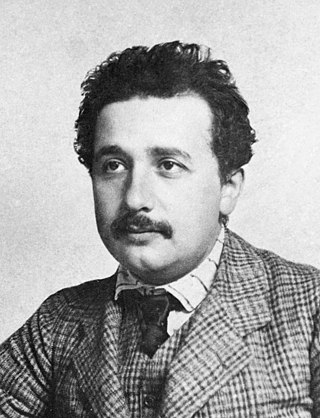
The annus mirabilis papers are the four papers that Albert Einstein published in Annalen der Physik, a scientific journal, in 1905. These four papers were major contributions to the foundation of modern physics. They revolutionized science's understanding of the fundamental concepts of space, time, mass, and energy. Because Einstein published all four of these papers in a single year, 1905 is called his annus mirabilis.
- The first paper explained the photoelectric effect, which established the energy of the light quanta , and was the only specific discovery mentioned in the citation awarding Einstein the 1921 Nobel Prize in Physics.
- The second paper explained Brownian motion, which established the Einstein relation and led reluctant physicists to accept the existence of atoms.
- The third paper introduced Einstein's theory of special relativity, which used the universal constant speed of light to derive the Lorentz transformations.
- The fourth, a consequence of the theory of special relativity, developed the principle of mass–energy equivalence, expressed in the equation and which led to the discovery and use of atomic energy decades later.

The Max Planck Institute for Gravitational Physics is a Max Planck Institute whose research is aimed at investigating Einstein's theory of relativity and beyond: Mathematics, quantum gravity, astrophysical relativity, and gravitational-wave astronomy. The institute was founded in 1995 and is located in the Potsdam Science Park in Golm, Potsdam and in Hannover where it closely collaborates with the Leibniz University Hannover. Both the Potsdam and the Hannover parts of the institute are organized in three research departments and host a number of independent research groups.

Friedwardt Winterberg is a German-American theoretical physicist and was a research professor at the University of Nevada, Reno. He is known for his research in areas spanning general relativity, Planck scale physics, nuclear fusion, and plasmas. His work in nuclear rocket propulsion earned him the 1979 Hermann Oberth Gold Medal of the Wernher von Braun International Space Flight Foundation and a 1981 citation by the Nevada Legislature. He is also an honorary member of the German Aerospace Society Lilienthal-Oberth.
Martin Jesse Klein, usually cited as M. J. Klein, was a science historian of 19th and 20th century physics.

Jürgen Ehlers was a German physicist who contributed to the understanding of Albert Einstein's theory of general relativity. From graduate and postgraduate work in Pascual Jordan's relativity research group at Hamburg University, he held various posts as a lecturer and, later, as a professor before joining the Max Planck Institute for Astrophysics in Munich as a director. In 1995, he became the founding director of the newly created Max Planck Institute for Gravitational Physics in Potsdam, Germany.
Ilse Rosenthal-Schneider was a German-Australian physicist and philosopher. She is best known for her collaboration and correspondence with physicists Albert Einstein, Max von Laue, and Max Planck. Rosenthal-Schneider earned a PhD in philosophy in 1920 at the University of Berlin, where she first met Albert Einstein. After leaving Nazi Germany and emigrating to Australia in 1938, she became a tutor in the German department at the University of Sydney in 1945 and taught history and philosophy of science. In the 1940s and 1950s, she exchanged a series of letters with Albert Einstein about philosophical aspects of physics, such as theory of relativity, fundamental constants and physical reality. She remained in contact with Einstein through correspondence until the death of Einstein in 1955. Rosenthal-Schneider contributed various articles and book reviews to the history of science journal Isis.
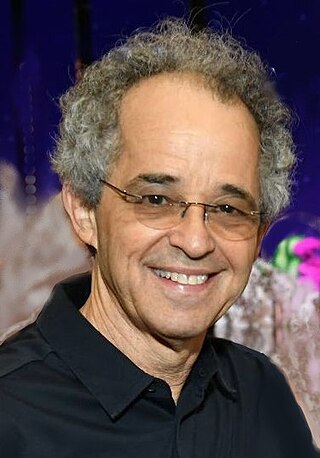
Leo Corry is an Israeli historian of mathematics.

Hanoch Gutfreund is the Andre Aisenstadt Chair in theoretical physics and was the president at the Hebrew University of Jerusalem. Prior to his presidency, he was a professor at the university.
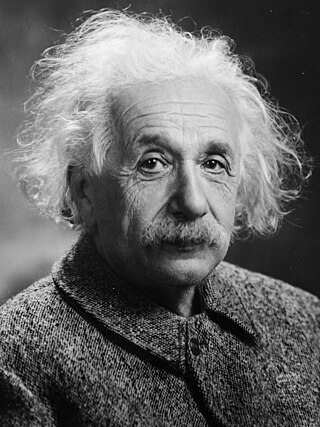
Albert Einstein's discovery of the gravitational field equations of general relativity and David Hilbert's almost simultaneous derivation of the theory using an elegant variational principle, during a period when the two corresponded frequently, has led to numerous historical analyses of their interaction. The analyses came to be called a priority dispute.
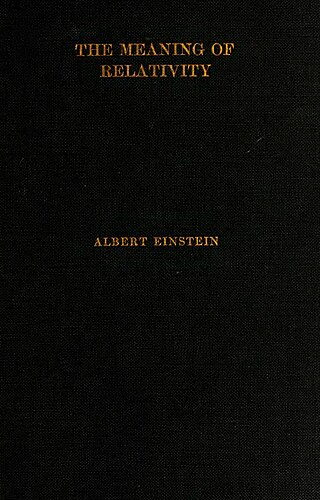
The Meaning of Relativity: Four Lectures Delivered at Princeton University, May 1921 is a book published by Princeton University Press in 1922 that compiled the 1921 Stafford Little Lectures at Princeton University, given by Albert Einstein. The lectures were translated into English by Edwin Plimpton Adams. The lectures and the subsequent book were Einstein's last attempt to provide a comprehensive overview of his theory of relativity and is his only book that provides an accessible overview of the physics and mathematics of general relativity. Einstein explained his goal in the preface of the book's German edition by stating he "wanted to summarize the principal thoughts and mathematical methods of relativity theory" and that his "principal aim was to let the fundamentals in the entire train of thought of the theory emerge clearly". Among other reviews, the lectures were the subject of the 2017 book The Formative Years of Relativity: The History and Meaning of Einstein's Princeton Lectures by Hanoch Gutfreund and Jürgen Renn.
Tilman Sauer is a German theoretical physicist and historian of the natural sciences. He has an international reputation as an expert on the history of the development of general relativity theory.
References
- ↑ The Massive Sine-Gordon Equation in Quantum Field Theory and Classical Statistical Mechanics, Some Rigorous Results
- ↑ "Renn, Jürgen - Geoanthropology".
- ↑ "Renn, Jürgen | Topoi".
- ↑ Hanoch Gutfreund, Jürgen Renn (2017). The Formative Years of Relativity: The History and Meaning of Einstein's Princeton Lectures. Princeton University Press. ISBN 978-0-691-17463-1 . Retrieved 21 January 2020.
- ↑ Hanoch Gutfreund, Jürgen Renn (2017). The Road to Relativity: The History and Meaning of Einstein's "The Foundation of General Relativity", Featuring the Original Manuscript of Einstein's Masterpiece. Princeton University Press. ISBN 978-0-691-17581-2 . Retrieved 21 January 2020.
- ↑ Jürgen Renn, Hanoch Gutfreund (2020). Einstein on Einstein: Autobiographical and Scientific Reflections. Princeton University Press. ISBN 978-0-691-18360-2 . Retrieved 21 January 2020.
- ↑ https://www.mpiwg-berlin.mpg.de/en/research/projects/DEPT1_10_20Buettner-OpenAccess and summarizing: Jürgen Renn, "Beyond editions: historical sources in the digital age," in Internationalität und Interdisziplinarität der Editionswissenschaft, edited by M. Stolz, & Y.-C. Chen, Berlin: De Gruyter 2014, pp. 9–28.
- ↑ Projects mpg.de [ dead link ]
- ↑ "Archived copy" (PDF). Archived from the original (PDF) on 12 May 2011. Retrieved 2 August 2011.
{{cite web}}: CS1 maint: archived copy as title (link) - ↑ "Edition Open Access".
- ↑ "Albert Einstein – Ingenieur des Universums".
- ↑ "Technikmuseum würdigt Max Planck". 26 April 2008.
- ↑ "Katalog – 300 Jahre Wissenschaften in Berlin". Archived from the original on 4 March 2016. Retrieved 18 June 2015.
- ↑ "Archimede. Arte e scienza dell'invenzione | Musei Capitolini".
- ↑ Claudia Tamiro, "Anassilaos, cultura d’esportazione," in Il Quotidiano (13.11.2011), at http://www.mpiwg-berlin.mpg.de/Presse-PDF/2011-11-13_IlQuotidianoAnassilaos.pdf
- ↑ "Archived copy" (PDF). Archived from the original (PDF) on 5 March 2016. Retrieved 18 June 2015.
{{cite web}}: CS1 maint: archived copy as title (link) - ↑ "Jürgen Renn Awarded the 2014 Francis Bacon Prize for Outstanding Scholarship in the History of Science | www.hss.caltech.edu". Archived from the original on 9 September 2015. Retrieved 18 June 2015.
- ↑ "Max-Planck-Communitas-Preis".
- ↑ "ESHS Neuenschwander Prize – Award and Prize organized by ESHS : European Society for the History of Science". Archived from the original on 11 September 2015. Retrieved 18 June 2015.